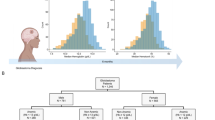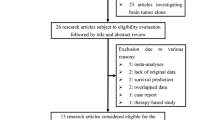Abstract
The HFE (high iron) protein plays a key role in the regulation of body iron. HFE polymorphisms (H63D and C282Y) are the common genetic variants in Caucasians. Based on frequency data, both HFE polymorphisms have been associated with increased risk in a number of cancers. The prevalence of the two major HFE polymorphisms in a human brain tumor patient populations and the impact of HFE polymorphisms on survival have not been studied. In the present study, there is no overall difference in survival by HFE genotype. However, male GBM patients with H63D HFE (H63D) have poorer overall survival than wild type HFE (WT) male GBM (p = 0.03). In GBM patients with the C282Y HFE polymorphism (C282Y), female patients have poorer survival than male patients (p = 0.05). In addition, female metastatic brain tumor patients with C282Y have shorter survival times post diagnosis than WT patients (p = 0.02) or male metastatic brain tumor patients with C282Y (p = 0.02). There is a tendency toward a lower proportion of H63D genotype in GBM patients than a non-tumor control group (p = 0.09) or other subtypes of brain tumors. In conclusion, our study suggests that HFE genotype impacts survival of brain tumor patients in a gender specific manner. We previously reported that glioma and neuroblastoma cell lines with HFE polymorphisms show greater resistance to chemo and radiotherapy. Taken together, these data suggest HFE genotype is an important consideration for evaluating and planning therapeutic strategies in brain tumor patients.


Similar content being viewed by others
Abbreviations
- ALL:
-
Acute lymphoblastic leukemia
- CBTRUS:
-
Central Brain Tumor Registry of the United States
- C282Y:
-
C282Y HFE polymorphism
- GBM:
-
Glioblastoma
- HCC:
-
Hepatocellular carcinoma
- H63D:
-
H63D HFE polymorphism
- Tf:
-
Transferrin
- TfR:
-
Transferrin receptor
- WT:
-
Wild type
References
Feder JN, Penny DM, Irrinki A, Lee VK, Lebron JA, Lebrón JA, Watson N, Tsuchihashi Z, Sigal E, Bjorkman PJ, Schatzman RC (1998) The hemochromatosis gene product complexes with the transferrin receptor and lowers its affinity for ligand binding. Proc Natl Acad Sci USA 95:1472–1477
Lebron JA, Bennett MJ, Vaughn DE, Chirino AJ, Snow PM, Mintier GA, Feder JN, Bjorkman PJ (1998) Crystal structure of the hemochromatosis protein HFE and characterization of its interaction with transferrin receptor. Cell 93:113–123
Zhou XY, Tomatsu S, Fleming RE, Parkkila S, Waheed A, Jiang J, Fei Y, Brunt EM, Ruddy DA, Prass CE, Schatzman RC, O’Neill R, Britton RS, Bacon BR, Sly WS (1998) HFE gene knockout produces mouse model of hereditary hemochromatosis. Proc Natl Acad Sci USA 95:2492–2497
Liu Y, Lee SY, Neely E, Nandar W, Moyo M, Simmons Z, Connor JR (2011) Mutant HFE H63D protein is associated with prolonged endoplasmic reticulum stress and increased neuronal vulnerability. J Biol Chem 286:13161–13170
Adams PC, Reboussin DM, Barton JC, McLaren CE, Eckfeldt JH, McLaren GD, Dawkins FW, Acton RT, Harris EL, Gordeuk VR, Leiendecker-Foster C, Speechley M, Snively BM, Holup JL, Thomson E, Sholinsky P; Hemochromatosis and Iron Overload Screening (HEIRS) Study Research Investigators (2005) Hemochromatosis and Iron Overload Screening (HEIRS) Study Research Investigators. Hemochromatosis and iron-overload screening in a racially diverse populations. N Engl J Med 352:1769–1778
Allen KJ, Gurrin LC, Constantine CC, Osborne NJ, Delatycki MB, Nicoll AJ, McLaren CE, Bahlo M, Nisselle AE, Vulpe CD, Anderson GJ, Southey MC, Giles GG, English DR, Hopper JL, Olynyk JK, Powell LW, Gertig DM (2008) Iron-overload-related disease in HFE hereditary hemochromatosis. N Engl J Med 358:221–230
Hanson EH, Imperatore G, Burke W (2001) HFE gene and hereditary hemochromatosis: a HuGE review, Human genome epidemiology. Am J Epidemiol 154:193–206
Alexander J, Kowdley KV (2009) HFE-associated hereditary hemochromatosis. Genet Med 11:307–313
Snyder AM, Connor JR (2009) Iron, the substantia nigra and related neurological disorders. Biochim Biophys Acta 1790:606–614
Connor JR, Lee SY (2010) Iron and cancer. In: Milner JA, Romagnolo DF (eds) Bioactive compounds and cancer. Humana Press, New York, pp 469–496
Ropero P, Briceño O, López-Alonso G, Agúndez JA, González Fernández FA, García-Hoz F, Villegas Martínez A, Díaz-Rubio M, Ladero JM (2007) The H63D mutation in the HFE gene is related to the risk of hepatocellular carcinoma. Rev Esp Enferm Dig 99:376–381
Gunel-Ozcan A, Alyilmaz-Bekmez S, Guler EN, Guc D (2006) HFE H63D mutation frequency shows an increase in Turkish women with breast cancer. BMC Cancer 6:37
Shi Z, Johnstone D, Talseth-Palmer BA, Evans TJ, Spigelman AD, Groombridge C, Milward EA, Olynyk JK, Suchy J, Kurzawski G, Lubinski, Scott RJ (2009) Haemochromatosis HFE gene polymorphisms as potential modifiers of hereditary nonpolyposis colorectal cancer risk and onset age. Int J Cancer 125:78–83
Varkonyi J, Demeter J, Tordai A, Andrikovics H (2006) The significance of the hemochromatosis genetic variants in multiple myeloma in comparison to that of myelodysplastic syndrome. Ann Hematol 85:869–871
Viola A, Pagano L, Laudati D, D’Elia R, D’Amico MR, Ammirabile M, Palmieri S, Prossomarti L, Ferrara F (2006) HFE gene mutations in patients with acute leukemia. Leuk Lymphoma 47:2331–2334
Martinez di Montemuros F, Tavazzi D, Salsano E, Piepoli T, Pollo B, Fiorelli G, Finocchiaro G (2001) High frequency of the H63D mutation of the hemochromatosis gene (HFE) in malignant gliomas. Neurology 57:1342
Cardoso CS, Araújo HC, Cruz E, Afonso A, Mascarenhas C, Almeida S, Moutinho J, Lopes C, Medeiros R (2006) Haemochromatosis gene (HFE) mutations in viral-associated neoplasia: linkage to cervical cancer. Biochem Biophy Res Commun 341:232–238
Jin F, Qu LS, Shen XZ (2010) Association between C282Y and H63D mutations of the HFE gene with hepatocellular carcinoma in European populations: a meta-analysis. J Exp Clin Cancer Res 29:18
Osborne NJ, Gurrin LC, Allen KJ, Constantine CC, Delatycki MB, McLaren CE, Gertig DM, Anderson GJ, Southey MC, Olynyk JK, Powell LW, Hopper JL, Giles GG, English DR (2010) HFE C282Y homozygotes are at increased risk of breast and colorectal cancer. Hepatology 51:1311–1318
Dorak MT, Burnett AK, Worwood M, Sproul AM, Gibson BE (1999) The C282Y mutations of HFE is another male-specific risk factor for childhood acute lymphoblastic leukemia. Blood 94:3957
Gannon PO, Medelci S, Le Page C, Beaulieu M, Provencher DM, Mes-Masson AM, Santos MM (2011) Impact of hemochromatosis gene (HFE) mutations on epithelial ovarian cancer risk and prognosis. Int J Cancer 128:2326–2334
CBTRUS (2013). CBTRUS Statistical Report: NPCR and SEER data from 2006–2010 In: Central Brain Tumor Registry of the United States
Patil CG, Pricola K, Garg SK, Bryant A, Black KL (2010) Whole brain radiation therapy (WBRT) alone versus WBRT and radiosurgery for the treatment of brain metastases. Cochrane Database Syst Rev 6:CD006121
Stupp R, Mason WP, van den Bent MJ, Weller M, Fisher B, Taphoorn MJ, Belanger K, Brandes AA, Marosi C, Bogdahn U, Curschmann J, Janzer RC, Ludwin SK, Gorlia T, Allgeier A, Lacombe D, Cairncross JG, Eisenhauer E, Mirimanoff RO; European Organisation for Research and Treatment of Cancer Brain Tumor and Radiotherapy Groups; National Cancer Institute of Canada Clinical Trials Group (2005) Radiotherapy plus concomitant and adjuvant temozolomide for glioblastoma. N Engl J Med 352:987–996
Lee SY, Patton SM, Henderson RJ, Connor JR (2007) Consequences of expressing mutants of the hemochromatosis gene (HFE) into a human neuronal cell line lacking endogenous HFE. FASEB J 21:564–576
Carella M, D’Ambrosio L, Totaro A, Grifa A, Valentino MA, Piperno A, Girelli D, Roetto A, Franco B, Gasparini P, Camaschella C (1997) Mutation analysis of the HLA-H gene in Italian hemochromatosis patients. Am J Hum Genet 60:828–832
Lee SY, Liu S, Mitchell RM, Slagle-Webb B, Hong YS, Sheehan JM, Connor JR (2011) HFE polymorphisms influence the response to chemotherapeutic agents via induction of p16INK4A. Int J Cancer 129:2104–2114
Dubrow R, Darefsky AS (2011) Demographic variation in incidence of adult glioma by subtype, United States, 1992-2007. BMC Cancer 11:325
Ali-Rahmani F, Huang MA, Schengrund CL, Connor JR, Lee SY (2014) C282Y-HFE gene variant affects cholesterol metabolism in human neuroblastoma cells. PLoS ONE 9(2):e88724
Acknowledgments
We thank the macromolecular synthesis core and functional genomics core at the Penn State Hershey Medical Center/Penn State Hershey College of Medicine for primer synthesis and DNA sequencing. We also thank to the research coordinators, data coordinators, and brain tumor patients who participate in our study. This work was supported in part by the Tara Leah Witmer Endowment and Pennsylvania Department of Health. The funders had no role in study design, data collection and analysis, decision to publish, or preparing of the manuscript.
Conflict of interest
Connor is partial owner of NuHope LLC which has a financial interest in development of compounds for treating brain tumors that were initially screened using cell lines chosen for HFE genotype. Lee has a royalty agreement with NuHope LLC.
Author information
Authors and Affiliations
Corresponding author
Electronic supplementary material
Below is the link to the electronic supplementary material.
Rights and permissions
About this article
Cite this article
Lee, S.Y., Slagle-Webb, B., Sheehan, J.M. et al. HFE polymorphisms affect survival of brain tumor patients. J Neurooncol 122, 97–104 (2015). https://doi.org/10.1007/s11060-014-1681-1
Received:
Accepted:
Published:
Issue Date:
DOI: https://doi.org/10.1007/s11060-014-1681-1




